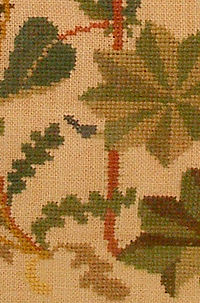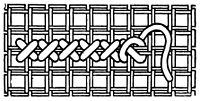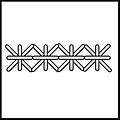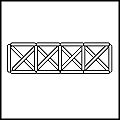


Cross stitches in embroidery, needlepoint, and other forms of needlework include a number of related stitches in which the thread is sewn in an x or + shape. Cross stitch has been called "probably the most widely used stitch of all" and is part of the needlework traditions of the Balkans, Middle East, Afghanistan, Colonial America and Victorian England.
Applications
Cross stitches were typical of 16th century canvas work, falling out of fashion in favor of tent stitch toward the end of the century. Canvas work in cross stitch became popular again in the mid-19th century with the Berlin wool work craze.
Herringbone, fishbone, Van Dyke, and related crossed stitches are used in crewel embroidery, especially to add texture to stems, leaves, and similar objects. Basic cross stitch is used to fill backgrounds in Assisi work.
Cross stitch was widely used to mark household linens in the 18th and 19th centuries, and girls' skills in this essential task were demonstrated with elaborate samplers embroidered with cross-stitched alphabets, numbers, birds and other animals, and the crowns and coronets sewn onto the linens of the nobility. Much of contemporary cross-stitch embroidery derives from this tradition.
Variants
Common variants of cross stitch include:
- Basic cross stitch
- Celtic cross stitch
- Long-armed cross stitch
- Double cross stitch
- Italian cross stitch
- Basket stitch
- Leaf stitch
- Herringbone stitch
- Closed herringbone stitch
- Tacked herringbone stitch
- Threaded herringbone stitch
- Tied herringbone stitch
- Montenegrin stitch
- Trellis stitch
- Thorn stitch
- Van Dyke stitch
The most famous are Italian cross embroidery, long arm cross embroidery, and Black Mountain embroidery. Italian cross embroidery and Montenegrin embroidery are reversible, which means that the work looks the same on both sides. These styles are a little different from regular cross stitch embroidery. These more intricate stitches are rarely used in traditional embroidery, but they are still used to recreate historical works of embroidery or by creative and adventurous embroiderers. Double cross embroidery, also known as Leviathan embroidery or Smyrna cross embroidery, combines cross embroidery vertically.
Berlin Woolwork and similar stitches petit point are reminiscent of the heavily brushed, luxurious styles of cross-stitch embroidery, and sometimes paper-printed diagrams are also used.
Gallery
-
 Basic cross stitch as worked in embroidery
Basic cross stitch as worked in embroidery
-
 Long-armed cross stitch
Long-armed cross stitch
-
 Double cross stitch
Double cross stitch
-
 Italian cross stitch
Italian cross stitch
-
 Basket stitch
Basket stitch
-
 Leaf stitch
Leaf stitch
-
 Herringbone stitch
Herringbone stitch
-
 Tacked herringbone stitch
Tacked herringbone stitch
-
 Tied herringbone stitch
Tied herringbone stitch
-
 Montenegrin stitch
Montenegrin stitch
-
 Thorn stitch
Thorn stitch
-
 Trellis stitch
Trellis stitch
-
 Van Dyke stitch
Van Dyke stitch
See also
Notes
- Gillow, John, and Bryan Sentance: World Textiles, Bulfinch Press/Little, Brown, 1999, ISBN 0-8212-2621-5, p. 181
- Levey, S. M. and D. King, The Victoria and Albert Museum's Textile Collection Vol. 3: Embroidery in Britain from 1200 to 1750, Victoria and Albert Museum, 1993, ISBN 1-85177-126-3
- Leszner, Eva Maria: Assisi Embroidery: Old Italian Cross Stitch Design, Batsford Press, 1988, ISBN 0-7134-5595-0, p. 29
- "What Exactly Is A Cross Stitch Sampler?". Retrieved 2024-12-03.
- Gillow and Sentance: World Textiles, p. 180-183
- Reader's Digest Complete Guide to Needlework. The Reader's Digest Association, Inc. (March 1992). ISBN 0-89577-059-8, p. 38
- "A Stitch in Time: Two-Sided Italian Cross-Stitch". pieceworkmagazine.com. Retrieved 2023-11-03.
- "Assisi Embroidery and Assisi Embroidery Patterns". www.needlepointers.com. Retrieved 2023-11-03.
- "Two-sided Italian cross stitch". rsnstitchbank.org. Retrieved 2023-11-03.
- "History of Cross-Stitch Embroidery". www.heartfuldiamonds.com. Retrieved 2023-11-03.
- "60+ different types of hand embroidery techniques". sewguide.com. Retrieved 2023-11-03.
- "Berlin woolwork". www.britannica.com. Retrieved 2023-11-03.
References
- Caulfield, S.F.A., and B.C. Saward, The Dictionary of Needlework, 1885.
- Enthoven, Jacqueline: The Creative Stitches of Embroidery, Van Norstrand Rheinhold, 1964, ISBN 0-442-22318-8
- Reader's Digest, Complete Guide to Needlework. The Reader's Digest Association, Inc. (March 1992). ISBN 0-89577-059-8
- Lemon, Jane, Metal Thread Embroidery, Sterling, 2004, ISBN 0-7134-8926-X, p. 112
- Levey, S. M. and D. King, The Victoria and Albert Museum's Textile Collection Vol. 3: Embroidery in Britain from 1200 to 1750, Victoria and Albert Museum, 1993, ISBN 1-85177-126-3
| Embroidery | ||
|---|---|---|
| Styles |    | |
| Stitches | ||
| Tools and materials | ||
| Regionaland historical | ||
| Embroideries |
| |
| Designersand embroiderers |
| |
| Organizationsand museums | ||
| Related | ||